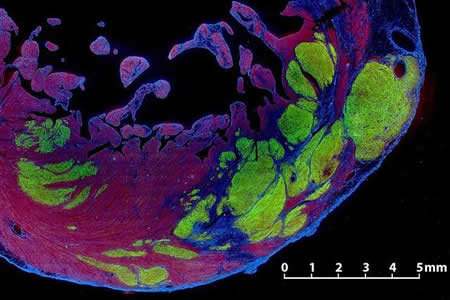Image credit: Xiulan Yang/Murry Lab, UW Medicine
Globally, heart failure is the leading cause of death and is most commonly the result of heart attacks. Heart attacks cause the death of heart muscle. In contrast to other muscular tissue, heart muscle cannot regenerate, instead damaged tissue is replaced with scar tissue which limits the ability of the heart to contract and pump blood. The heart becomes weaker, and eventually so weak that it cannot pump blood around the body and supply tissues with oxygen. The only hope for patients is a heart transplant.
However, stem cells offer some hope and significant progress has been made in this area. Researchers at the University of Washington School of Medicine have successfully used human stem cells to treat macaque monkeys with heart disease and restore heart function. Macaque monkeys were chosen for the study as their heart physiology closely matches human heart physiology.
Heart attacks were induced in the monkeys, which reduced left ventricular ejection fractions from around 65% to 40%. After two weeks, the researchers injected around 750 million human embryonic stem cell–derived cardiomyocytes into the young scar tissue of each monkey. A cell free injection was given to a control group.
Four weeks following the injections, left ventricular ejection fractions had not improved in the control group, whereas the monkeys that received the stem cells had average left ventricular ejection fractions of 49.7%.
The transplanted stem cells developed into ventricular myocytes and formed electromechanical junctions with the monkeys’ own heart tissue, significantly improving ventricular function and causing the ventricle to pump more vigorously.
Two monkeys and one control group monkey were assessed three months following the injections. The control group monkey showed a decline in ejection fraction, whereas the stem-cell treated monkeys’ ejection fractions rose to 61% and 66% – not far short of normal levels.
In the above image, the green area shows human embryonic stem cell–derived cardiomyocytes integrated into the heart wall (red) with the blue area showing scarring. Examination of the hearts showed that between 10% and 29% of scar tissue had been replaced with healthy heart tissue
“Our findings show that human embryonic stem cell-derived cardiomyocytes can re-muscularize infarcts in macaque monkey hearts and, in doing so, reduce scar size and restore a significant amount of heart function,” said Dr. Charles Murray, professor of pathology at the UW Medicine and head of the research project.
The researchers hope that the successes could lead to the use of stem cells in the treatment of human patients diagnosed with heart disease. If stem cells are administered immediately following a heart attack, it should be possible to prevent heart failure. “What we hope to do is create a ‘one-and-done’ treatment with frozen ‘off-the-shelf’ cells that, like O-negative blood, can go into any recipient with only moderate immune suppression.”
The research is detailed in the paper – Human embryonic stem cell–derived cardiomyocytes restore function in infarcted hearts of non-human primates – which was published in the journal Nature Biotechnology
